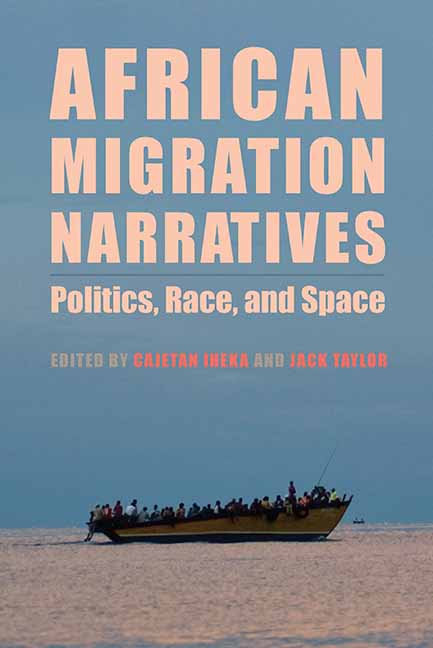Book contents
- Frontmatter
- Contents
- Acknowledgments
- Introduction: The Migration Turn in African Cultural Productions
- Part One African Migration on the Screen: Films of Migration
- Part Two Forgotten Diasporas: Lusophone and Indian Diasporas
- Part Three Migration against the Grain: Narratives of Return
- 8 Reading Space, Subjectivity, and Form in the Twenty-First-Century Narrative of Return
- 9 Looking for Transwonderland: Noo Saro-Wiwa's Migration of the Heart
- 10 The Literary Circulation of Teju Cole's Every Day Is for the Thief
- 11 Speculative Migration and the Project of Futurity in Sylvestre Amoussou's Africa Paradis
- Part Four Migration and Difference: Indigeneity, Race, Religion, and Poetry at the Margins
- Bibliography
- Notes on Contributors
- Index
10 - The Literary Circulation of Teju Cole's Every Day Is for the Thief
from Part Three - Migration against the Grain: Narratives of Return
Published online by Cambridge University Press: 26 July 2019
- Frontmatter
- Contents
- Acknowledgments
- Introduction: The Migration Turn in African Cultural Productions
- Part One African Migration on the Screen: Films of Migration
- Part Two Forgotten Diasporas: Lusophone and Indian Diasporas
- Part Three Migration against the Grain: Narratives of Return
- 8 Reading Space, Subjectivity, and Form in the Twenty-First-Century Narrative of Return
- 9 Looking for Transwonderland: Noo Saro-Wiwa's Migration of the Heart
- 10 The Literary Circulation of Teju Cole's Every Day Is for the Thief
- 11 Speculative Migration and the Project of Futurity in Sylvestre Amoussou's Africa Paradis
- Part Four Migration and Difference: Indigeneity, Race, Religion, and Poetry at the Margins
- Bibliography
- Notes on Contributors
- Index
Summary
The cover image shows four or five figures, perhaps a family, astride a motorcycle that speeds underneath an overpass in Lagos and past the camera. The motion blurs their faces and bodies. In the background, three police officers look on. One stands while the others recline against the flyover's concrete supports, which are plastered with posters advertising Nollywood's newest releases. It is a scene of street life in Lagos. The pattern of posters, the concrete structures, the family squeezed onto a two-seater motorcycle, and the three narcoleptic policemen of the postcolony taken collectively are mundane but meaningful. This is the image that addresses readers who pick up the original printing of Teju Cole's Every Day Is for the Thief, which was first published in 2007 by the Nigerian publisher Cassava Republic Press. Seven years later the novel is rereleased by the publishing giant Penguin Random House and distributed transnationally. The family, police, and posters have disappeared, replaced by different cover designs in different countries. The reprinted edition features new images, revised text, and a fresh context for circulation given the author's notoriety following the positive international reception of Open City. Nothing in the Random House edition, save fine print in the front matter, would suggest to the reader that they are holding the author's first work, a Nigerian novel.
The migration of Every Day, its revisions, and its place in the author's body of writing raises a long-standing question in a new way: what are we reading when we read African writing today? Recent work on this topic has produced compelling arguments by sampling across several texts that allow us to discern patterns in contemporary literary production. Indispensable as such work has been, here I trace a slightly different route that focuses on one text and its various forms as it “migrated” from a local Nigerian readership out into the global market of “world literature.” After all, the migration of people, ideas, and commodities is not only the subject matter of new African writing. Migration is also the condition in which that writing itself exists.
So what are we reading? There are several ways to answer the question. First, we can interrogate the patterns that characterize what Akin Adesokan calls new African writing, including the stylistic, thematic, and generic shifts, and continuity with past generations of writers.
- Type
- Chapter
- Information
- African Migration NarrativesPolitics, Race, and Space, pp. 173 - 188Publisher: Boydell & BrewerPrint publication year: 2018

